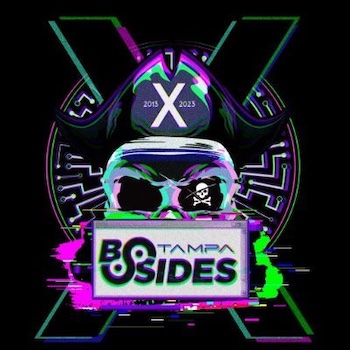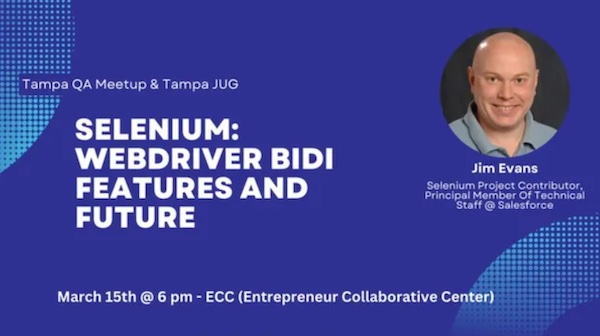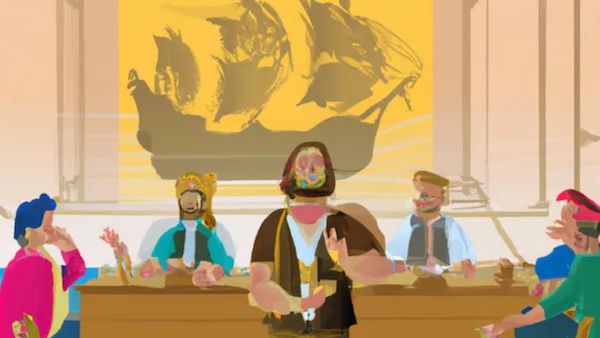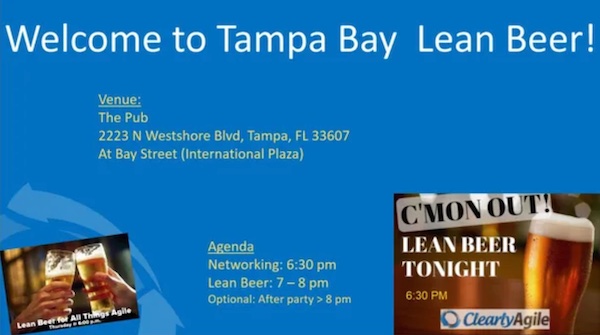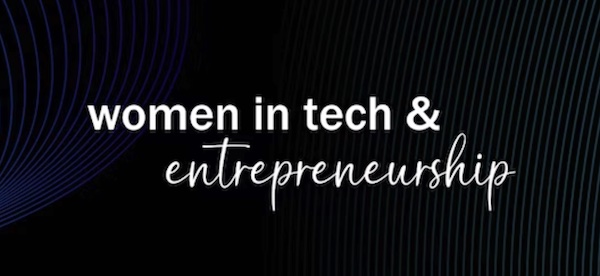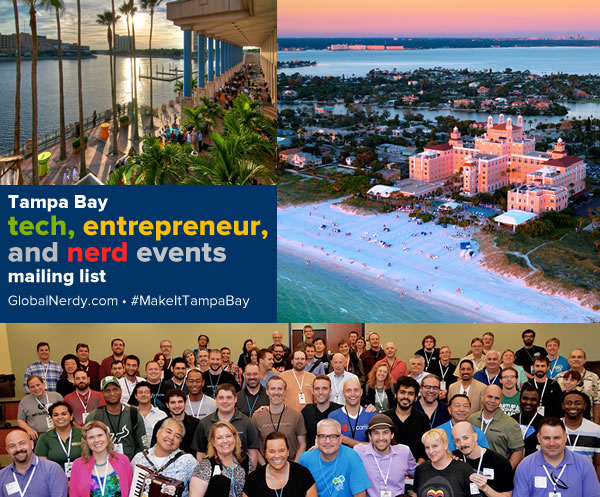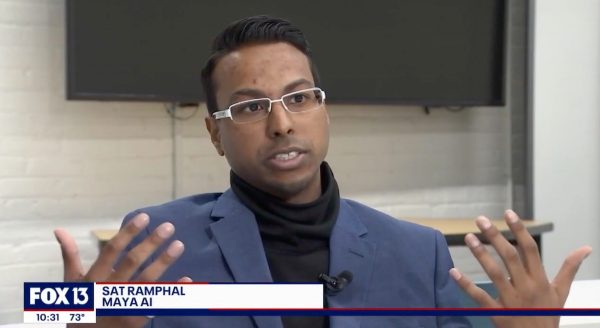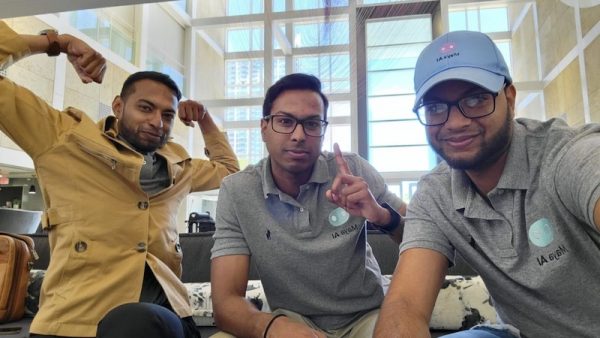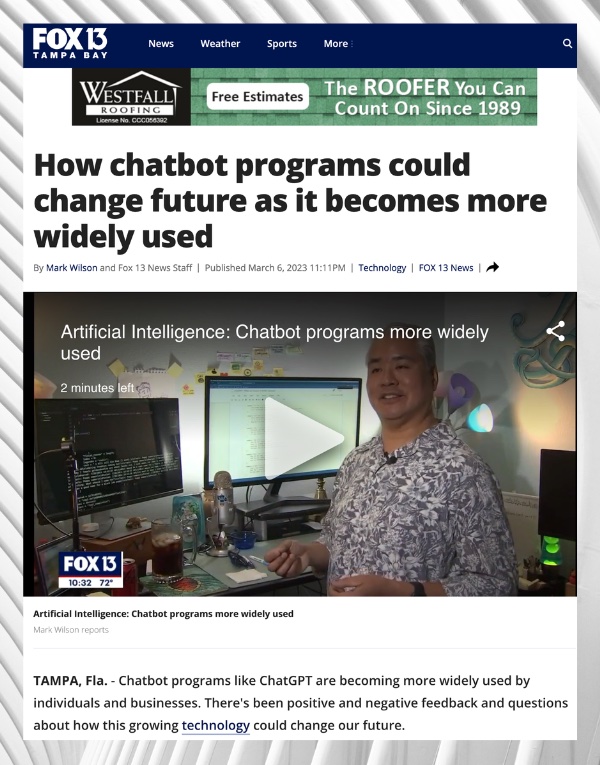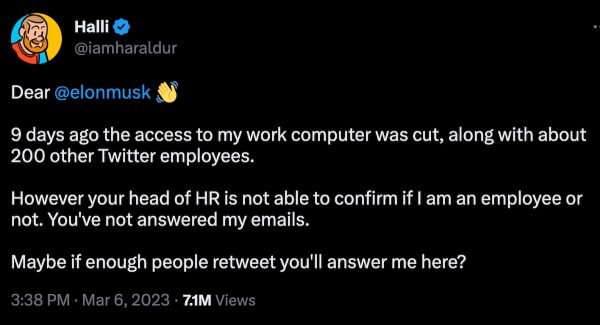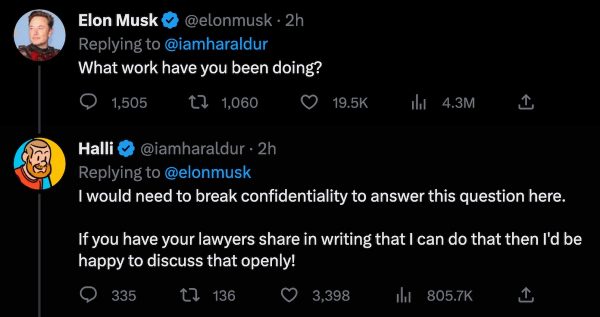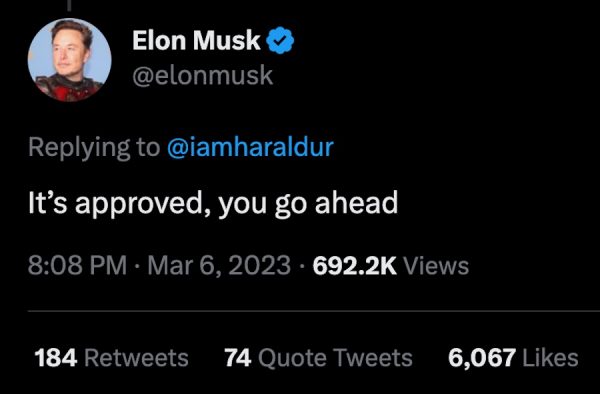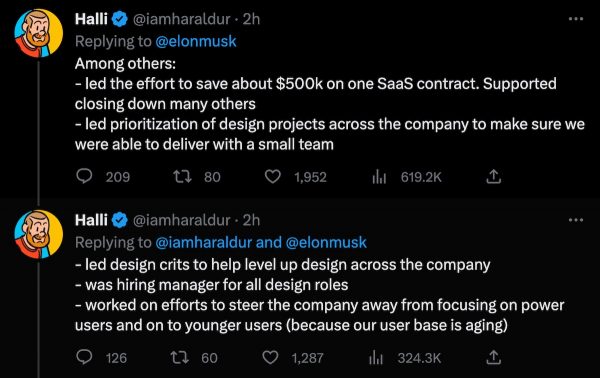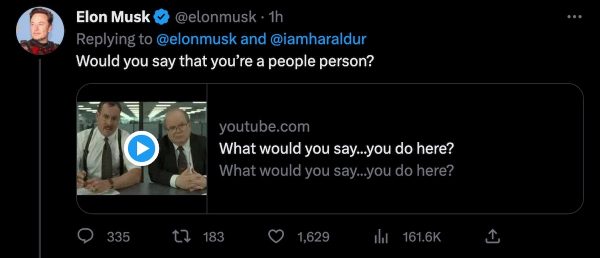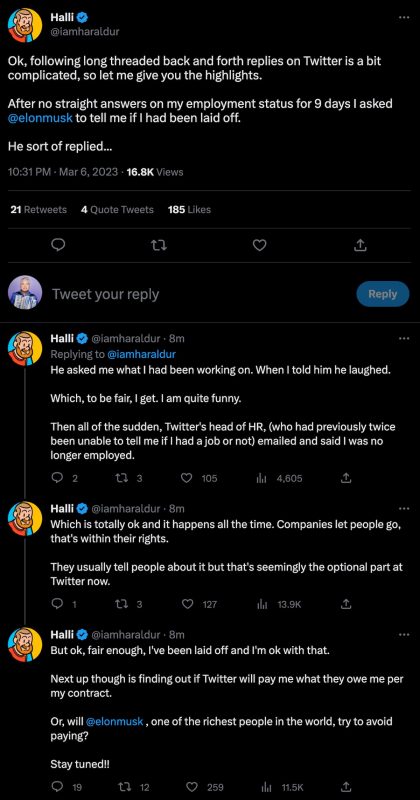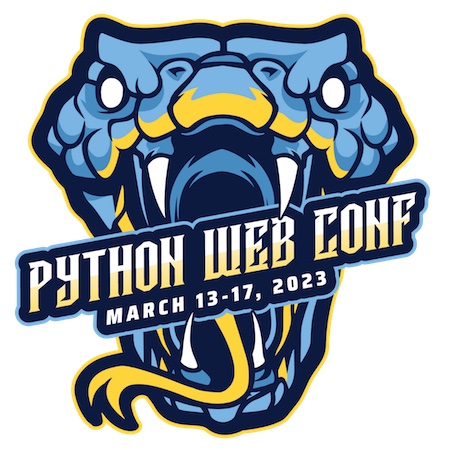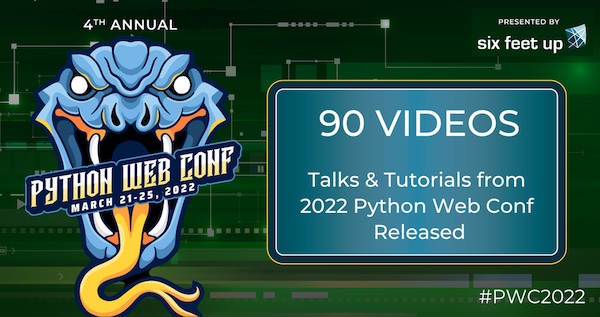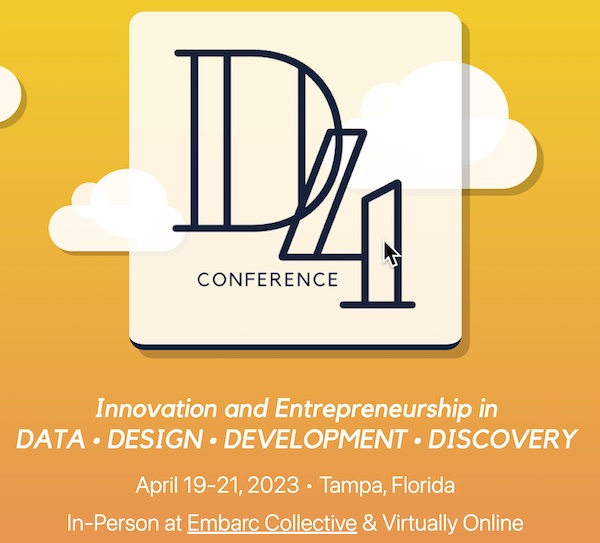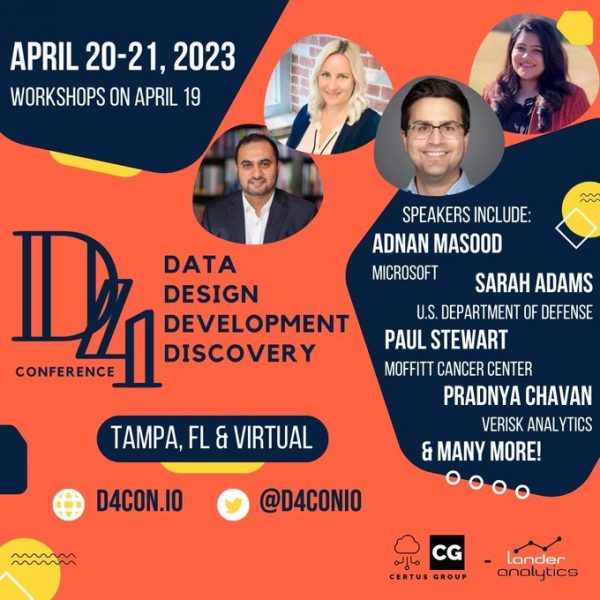
Here’s the “official unofficial” list of tech, entrepreneur, and nerd events for Tampa Bay and surrounding areas for the week of Monday, March 13 through Sunday, March 19, 2023.
This week’s events
Monday, March 13
| Group | Event Name | Time |
|---|---|---|
| JW Marriott Tampa Water Street • Tampa, FL | 2023 T3 Conference – Sponsorships | Mon, Mar 13, 8:00 AM |
| TampaBayNetworkers • Pinellas Park, FL | Success Builders Free Business Blog | Mon, Mar 13 · 9:00 AM EDT |
| Schellman Compliance Headquarters • Tampa, FL | Certified CMMC Assessor (CCA) Training | Mon, Mar 13, 9:00 AM |
| Agilest Tampa Downtown Office • Tampa, FL | SAFe Training Florida Tampa – SAFe Scrum Master Training SSM Certification | Mon, Mar 13, 9:00 AM |
| Agilest Downtown Tampa Office • Tampa, FL | SAFe DevOps Training SDP Certification Scaled Agile Training Florida Tampa | Mon, Mar 13, 9:00 AM |
| Young Professionals Networking JOIN in and Connect! • Saint Petersburg, FL | In person at Fords Garage St Pete | Mon, Mar 13 · 11:00 AM EDT |
| Tampa Bay Network and Social Events • Largo, FL | Networking at Ford’s Garage | Mon, Mar 13 · 11:00 AM EDT |
| Tampa / St Pete Business Connections • Tampa, FL | Downtown St Pete Business Professionals Lunch | Mon, Mar 13 · 11:00 AM EDT |
| Young Professionals Networking JOIN in and Connect! • Saint Petersburg, FL | Start the Week with more connections MONDAYS at Cafe Delanie All Welcome ! | Mon, Mar 13 · 11:30 AM EDT |
| Tampa Bay Network and Social Events • Largo, FL | Networking at Cafe’ Delanie | Mon, Mar 13 · 11:30 AM EDT |
| Christian Professionals Network Tampa Bay • Largo, FL | Business Networking Meeting | Mon, Mar 13 · 11:30 AM EDT |
| Entrepreneurs Empower Empire • Orlando, FL | Entrepreneurs Empower Empire Official Meeting- | Mon, Mar 13 · 11:30 AM EDT |
| Entrepreneurs’ Empowerment Empire • Orlando, FL | Official Meeting- | Mon, Mar 13 · 11:30 AM EDT |
| Tampa Bay Business Networking Meetings & Mixers • Tampa, FL | Monday Business Introductions | Mon, Mar 13 · 11:30 AM EDT |
| Professional Business Networking with RGAnetwork.net • Tampa, FL | In PERSON Networking Lunch Sabal Park/Brandon Reserve your seat | Mon, Mar 13 · 11:30 AM EDT |
| TampaBay-Job-Links | Gulf Coast JFCS • Tampa, FL | Kick-Off Monday: Live & In Person: “Interview Lab” | Mon, Mar 13, 1:00 PM |
| Free Video Production Classes – TV/Internet • Tampa, FL | YouTube Basics (ONLINE CLASS) – FREE for Hillsborough County Residents | Mon, Mar 13 · 4:00 PM EDT |
| Tampa Bay Tabletoppers • Tampa, FL | Monday Feast & Game Night | Mon, Mar 13 · 6:00 PM EDT |
| Critical Hit Games • Saint Petersburg, FL | MTG: Commander Night | Mon, Mar 13 · 6:00 PM EDT |
| Board Game Meetup: Board Game Boxcar • Orlando, FL | Monday Weekly Board Game Night! (Lazy Moon Colonial Location) | Mon, Mar 13 · 6:00 PM EDT |
| Orlando Adventurer’s Guild • Orlando, FL | [In-Person]: Swords Beneath the Moonsea (Tier 2, APL 8)- DM Calvin | Mon, Mar 13 · 6:00 PM EDT |
| Brews N Board Games • Orlando, FL | Board Game Night at Persimmon Hollow Flamingo Crossings | Mon, Mar 13 · 6:00 PM EDT |
| Tampa Hackerspace • Tampa, FL | Introduction to Fusion 360 | Mon, Mar 13 · 7:00 PM EDT |
| Tampa Startup Founder 101 • Tampa, FL | How to Launch, Grow, and Monetize a Marketplace w/ Agata Krzysztofi | Mon, Mar 13 · 7:00 PM EDT |
| Monster Learn-To-Trade Crypto (Online) • Maitland, FL | 🔥LIVE Trading Evening Show on Stocks, Forex, Crypto, Etc with David Stephenson | Mon, Mar 13 · 7:00 PM EDT |
| Tampa Bay Gaming: RPG’s, Board Games & more! • Tampa, FL | Board Game Night at Armada Games | Mon, Mar 13 · 7:00 PM EDT |
| Saint Petersburg Ladies book club • Saint Petersburg, FL | St. Pete Women’s Book Club | Mon, Mar 13 · 7:00 PM EDT |
| Light Study PRO – A Photography Workshop for Emerging Pros • Miami, FL | Members as far back as 2008 can access their photos | Mon, Mar 13 · 7:00 PM EDT |
| Library Book Clubs – OCLS • Orlando, FL | Virtual Event: Southeast Book Club | Mon, Mar 13 · 7:00 PM EDT |
| Orlando Stoics • Winter Park, FL | Special Event: Summit on Religious Freedom (Civil Discourse) | Mon, Mar 13 · 7:00 PM EDT |
| Meet New People As Adults – Which is Harder Than Expected • Palm Harbor, FL | Trivia Night to Meet New People | Mon, Mar 13 · 7:00 PM EDT |
| Sunshine Games • Tampa, FL | DigiMondays | Mon, Mar 13 · 7:30 PM EDT |
| Digital Entrepreneurship- Multiple sources of Income • Orlando, FL | How to make money online | Mon, Mar 13 · 9:00 PM EDT |
Tuesday, March 14
On Tuesday, Defcon813 is hosting a session called PacketStunts: Protocol Primer for BSides Tampa. Whether you’re looking for an introduction or a refresher on traditional networking protocols, this session is intended to help build a solid foundation in the operation of critical network protocols, and is intended to prepare you for challenges at BSides Tampa’s Networking Village. Find out more and register here.
⭐️ Want to know more about BSides Tampa? I wrote about it a few days back.
| Group | Event Name | Time |
|---|---|---|
| Tampa Bay Agile • Tampa, FL | v-Lean Coffee | Tue, Mar 14 · 7:30 AM EDT |
| Network Professionals Inc. of South Pinellas (NPI) • Saint Petersburg, FL | NPI St. Pete Business Builders Chapter – Exchange Qualified Business Referrals | Tue, Mar 14 · 7:30 AM EDT |
| 400 N Tampa St 15th floor • Tampa, FL | ActiveCampaign Study Hall | Tampa | Tue, Mar 14, 8:00 AM |
| The Attic On Kennedy • Tampa, FL | Breakfast And Referrals | Tue, Mar 14, 8:30 AM |
| Tampa Bay InfraGard Meetup Group • Tampa, FL | March Membership Meeting (Open to Anyone) | Tue, Mar 14 · 9:00 AM EDT |
| Suncoast Credit Union Micro Enterprise Development Meetup • Tampa, FL | Bidding 2 Win: Contracting and Sub-contracting with Hillsborough County | Tue, Mar 14 · 9:30 AM EDT |
| Orlando Melrose Makers • Orlando, FL | In-Person: Makerspace Open Lab | Tue, Mar 14 · 10:30 AM EDT |
| Business Professionals of Pinellas, Pasco & Hillsborough • Largo, FL | Tuesday Westchase SeaGlass Business Networking Lunch | Tue, Mar 14 · 11:00 AM EDT |
| Florida Startup: Idea to IPO • Tampa, FL | How to Find Product Market Fit Quickly | Tue, Mar 14 · 11:00 AM EDT |
| Young Professionals Networking JOIN in and Connect! • Saint Petersburg, FL | Westchase Professional Business Networking Lunch ~ All Welcome | Tue, Mar 14 · 11:00 AM EDT |
| Tampa Bay Network and Social Events • Largo, FL | Networking at SeaGlass Tavern~ All Welcome, join us!!! | Tue, Mar 14 · 11:00 AM EDT |
| The Entrepreneurs Success Academy • Sarasota, FL | Virtual Networking and Members Meetup | Tue, Mar 14 · 11:00 AM EDT |
| Tampa / St Pete Business Connections • Tampa, FL | Westchase Business Networking Lunch ~ All Welcome JOIN us and connect! | Tue, Mar 14 · 11:00 AM EDT |
| Tampa Bay Business Networking Meetings & Mixers • Tampa, FL | Westchase Networking Lunch -SeaGlass Tavern~ Meet your next referral | Tue, Mar 14 · 11:00 AM EDT |
| SeaGlass Tavern • Tampa, FL | Westchase Business Lunch all Welcome! JOIN us at SeaGlass Tavern11AM | Tue, Mar 14, 11:00 AM |
| Wesley Chapel, Trinity, New Tampa, Business Professionals • Wesley Chapel, FL | New Tampa Networking Lunch at Glory Day’s Grill New Tampa | Tue, Mar 14 · 11:30 AM EDT |
| Tampa Bay Network and Social Events • Largo, FL | Networking at Glory Days Grill | Tue, Mar 14 · 11:30 AM EDT |
| Pasco County Young Entrepreneurs/Business Owners All Welcome • Wesley Chapel, FL | Professional Business Networking Lunch Glory Day’s New Tampa | Tue, Mar 14 · 11:30 AM EDT |
| SWAT Networking – Successful Women Aligning Together • Bradenton, FL | SWAT Networking Lakewood Ranch Luncheon | Tue, Mar 14 · 11:30 AM EDT |
| Suncoast Business Network • Sarasota, FL | Networking and Lunch | Tue, Mar 14 · 11:30 AM EDT |
| PDM-SWUG, SolidWorks User Group • Riverview, FL | PDM SWUGs Breakfast, Lunch & Dinner! (and maybe a midnight snack) | Tue, Mar 14 · 12:00 PM EDT |
| Simply Referrals Tampa Business Networking • Tampa, FL | The Business Networking Midday Power Hour by Simply Referrals on Zoom! | Tue, Mar 14 · 12:00 PM EDT |
| Clearwater Business Networking • Clearwater, FL | The Business Networking Midday Power Hour by Simply Referrals on Zoom! | Tue, Mar 14 · 12:00 PM EDT |
| Ironhack Tampa – Tech Careers, Learning and Networking • Tampa, FL | Designing with AI: Taking Your Ideas from Concept to Creation | Tue, Mar 14 · 1:00 PM EDT |
| Freelancers Work Remote Meetup Group • Saint Petersburg, FL | Kahwa Coffee – Downtown St. Pete | Tue, Mar 14 · 1:00 PM EDT |
| WEB3CFL -Art -Music -Gaming -ai -Bitcoin -Crypto -Blockchain • Orlando, FL | Bitcoin/Crypto. Buying, Selling and sharing ideas. Small group atmosphere. | Tue, Mar 14 · 1:00 PM EDT |
| Network After Work Tampa – Networking Events • Tampa, FL | How to use AI for Business Development & Marketing to grow your Business | Tue, Mar 14 · 3:00 PM EDT |
| Free Video Production Classes – TV/Internet • Tampa, FL | Social Video Marketing Tips(ONLINE CLASS)-FREE for Hillsborough County Residents | Tue, Mar 14 · 4:30 PM EDT |
| Orlando Unity Developers Group • Orlando, FL | Metaverse Orlando: Navigating the Future of Digital Twins and Extended Realities | Tue, Mar 14 · 5:00 PM EDT |
| Melrose Center • Orlando, FL | Metaverse Orlando: Navigating the Future of Digital Twins and XR | Tue, Mar 14, 5:00 PM |
| Tampa Hackerspace • Tampa, FL | Weekly Open Make Night | Tue, Mar 14 · 6:00 PM EDT |
| St. Petersburg Business Networking Pick-up Basketball • Saint Petersburg, FL | Weekly pickup networking basketball | Tue, Mar 14 · 6:00 PM EDT |
| Nerdbrew Events • Tampa, FL | Spookeasy MtG Ybor Tuesdays! | Tue, Mar 14 · 6:00 PM EDT |
| Critical Hit Games • Saint Petersburg, FL | Hobby Night | Tue, Mar 14 · 6:00 PM EDT |
| Florida Center for Creative Photography • Saint Petersburg, FL | Meet & Greet at O’Keefe’s Family Restaurant | Tue, Mar 14 · 6:00 PM EDT |
| Nerd Night Out • Tampa, FL | SpookEasy Kava Bar MtG Night | Tue, Mar 14 · 6:00 PM EDT |
| The Hangar Restaurant • St. Petersburg, FL | Power Gals Of St Pete After Hours Women’s Networking Mixer | Tue, Mar 14, 6:00 PM |
| Young Entrepreneurs of America YEA Meetup Group • Tampa, FL | YEA Young Entrepreneur Meetup! Seminar & Networking | Tue, Mar 14 · 6:30 PM EDT |
| Florida Podcasters Association • Tampa, FL | Florida Podcasters Association General Meeting!!! | Tue, Mar 14 · 6:30 PM EDT |
| Tampa eMarketing Groups • Tampa, FL | Learn About Podcasting and How to Monetize Your Interest! | Tue, Mar 14 · 6:30 PM EDT |
| Orlando ServiceNow Developer Meetup • Orlando, FL | App Engine Studio, Lab, and more! | Tue, Mar 14 · 6:30 PM EDT |
| Tampa – Sarasota – Venice Trivia & Quiz Meetup • Bradenton, FL | Trivia Night – Moose Lodge 2117 Smartphone Trivia Game Show | Tue, Mar 14 · 6:30 PM EDT |
| Pinellas Writers • Largo, FL | Weekly Group Meetings – All Writers Welcome! | Tue, Mar 14 · 6:30 PM EDT |
| Shut Up & Write!® Orlando • Orlando, FL | Shut Up & Write!® in Altamonte Springs/Lake Mary | Tue, Mar 14 · 6:30 PM EDT |
| Entrepreneur Collaborative Center • Tampa, FL | YEA Young Entrepreneurs of America | Tue, Mar 14, 6:30 PM |
| Defcon813 • Tampa, FL | PacketStunts: Protocol Primer for Bsides Tampa | Tue, Mar 14 · 7:00 PM EDT |
| Tampa Hackerspace • Tampa, FL | Woodshop Safety (Members Only) | Tue, Mar 14 · 7:00 PM EDT |
| Sunshine Games • Tampa, FL | Yu-Gi-Oh Evening Tournament | Tue, Mar 14 · 7:00 PM EDT |
| Tampa Bay Gaming: RPG’s, Board Games & more! • Tampa, FL | D&D Adventurers League at Armada Games | Tue, Mar 14 · 7:00 PM EDT |
| St. Pete Beers ‘n Board Games for Young Adults • Saint Petersburg, FL | St. Pete Beers ‘n Board Games Meetup for Young Adults | Tue, Mar 14 · 7:00 PM EDT |
| LIVE-LOVE AND ENJOY! • Clearwater, FL | ITS GAME NIGHT !!! | Tue, Mar 14 · 7:00 PM EDT |
| Recess and Refresh- Playing fun active recess style games • Sarasota, FL | Recess and Refresh | Tue, Mar 14 · 7:00 PM EDT |
| Professionals Meetup For Networking And Social Skillsets • Orlando, FL | Discover Your Love Language | Tue, Mar 14 · 7:00 PM EDT |
| Writers of Central Florida • Auburndale, FL | Clean Fiction Writers March Meetup | Tue, Mar 14 · 7:00 PM EDT |
| Orlando Horror Movie Fans 20s-30s • Orlando, FL | SCREAM VI | Tue, Mar 14 · 7:05 PM EDT |
| TB Chess – Tampa Bay – St. Petersburg Chess Meetup Group • Saint Petersburg, FL | Let’s play chess at 54th Ave Kava House! | Tue, Mar 14 · 7:30 PM EDT |
| Digital Entrepreneurship- Multiple sources of Income • Orlando, FL | Trading Tuesday with a Professional Trader | Tue, Mar 14 · 9:00 PM EDT |
Wednesday, March 15
Also on Wednesday, the Tampa Java User Group and the Tampa QA group come together to talk about Selenium 4 and its bidirectional APIs, which allow for things like intercepting network requests, mock backends, performing basic authentication, and viewing the console logs. Find out more and register here.
Also on Wednesday: Tampa Devs is hosting a career panel talk featuring the following:
- Opening remarks from USF’s , Career and Technical/Workforce Education Professor Noemi Nagy
- Moderation by Nadia Khristean, software engineer
- and the panelists:
- Connor Tumbleson, Tech Lead at the software development agency Sourcetoad
- Ashley Putnam, Director at the recruiting firm Patriot Talent Solutions
- Chris Morancie, CTO at Net Synergy Virtual Solutions, assisting hiring in underpriviliged communities
Find out more and register here.
| Group | Event Name | Time |
|---|---|---|
| Young Professionals Networking JOIN in and Connect! • Saint Petersburg, FL | St Pete Networking Breakfast at the Hangar Meet St Pete’s Top Pro’s All Weclcome | Wed, Mar 15 · 7:30 AM EDT |
| Tampa Bay Network and Social Events • Largo, FL | Networking at The Hanger Restaurant & Flight Lounge! | Wed, Mar 15 · 7:30 AM EDT |
| Network Professionals Inc. of South Pinellas (NPI) • Saint Petersburg, FL | NPI Profit Partners Chapter – Exchange Qualified Business Referrals | Wed, Mar 15 · 7:30 AM EDT |
| 1 Million Cups – Orlando • Orlando, FL | 1 Million Cups – Orlando Weekly Meetup | Wed, Mar 15 · 8:30 AM EDT |
| Suncoast Drone Club • Tampa, FL | Pop Stansell Park | Wed, Mar 15 · 9:00 AM EDT |
| Entrepreneur Collaborative Center • Tampa, FL | 1 Million Cups Tampa 2023! | Wed, Mar 15, 9:00 AM |
| Florida Center for Creative Photography • Saint Petersburg, FL | Continue the Learning over Lunch at O’Keefe’s | Wed, Mar 15 · 11:00 AM EDT |
| Tampa Bay Networking Meetings and Mixers • Tampa, FL | Carrollwood Networking Lunch! Join us and win! | Wed, Mar 15 · 11:30 AM EDT |
| Tampa Bay Network and Social Events • Largo, FL | Networking at Glory Days Grill! | Wed, Mar 15 · 11:30 AM EDT |
| Young Professionals Networking JOIN in and Connect! • Saint Petersburg, FL | Brandon Business Professionals Just Love Coffee | Wed, Mar 15 · 11:30 AM EDT |
| Tampa / St Pete Business Connections • Tampa, FL | Brandon Business Professionals IN Person!!!! | Wed, Mar 15 · 11:30 AM EDT |
| Tampa Bay Network and Social Events • Largo, FL | Networking at Just Love Coffee! | Wed, Mar 15 · 11:30 AM EDT |
| Bradenton/Sarasota Networking Meetings and Mixers • Sarasota, FL | Business Networking Lunch | Wed, Mar 15 · 11:30 AM EDT |
| Tampa Bay Network and Social Events • Largo, FL | Networking at Rusty Bucket Restaurant and Tavern! | Wed, Mar 15 · 11:30 AM EDT |
| Tampa Bay Business Networking Meetings & Mixers • Tampa, FL | Brandon Networking Professionals Networking Lunch | Wed, Mar 15 · 11:30 AM EDT |
| Professional Business Networking with RGAnetwork.net • Tampa, FL | Carrollwood Professional Networking Lunch Wednesday All Welcome JOIN us | Wed, Mar 15 · 11:30 AM EDT |
| Entrepreneurs & Business Owners of Sarasota & Bradenton • Sarasota, FL | Sarasota Business Networking Lunch All Welcome, Just purchase Lunch! | Wed, Mar 15 · 11:30 AM EDT |
| ECPI University • Lake Mary, FL | Central Florida ISSA March 2023 Lunch and Learn | Wed, Mar 15, 11:30 AM |
| Marriott – St. Petersburg/Clearwater • St Petersburg, FL | Tampa Bay RIMS March 2023 Meeting | Wed, Mar 15, 11:30 AM |
| Glory Days Grill • Tampa, FL | 11:30AM Wednesday Carrollwood Professional Networking at Glory Days Grill! | Wed, Mar 15, 11:30 AM |
| Just Love Coffee Cafe – Brandon FL • Brandon, FL | Brandon Young Professionals Networking Lunch at Just Love Coffee Wednesdays | Wed, Mar 15, 11:30 AM |
| Learn Cybersecurity Tampa | Flatiron School • Tampa, FL | Women Talk Tech | Empowering Women for the Future | Wed, Mar 15 · 1:00 PM EDT |
| I Refuse 2 Fail Virtual Meetings • Pinellas Park, FL | FREE 15+30 Virtual Meetings | Wed, Mar 15 · 2:45 PM EDT |
| TampaBayNetworkers • Pinellas Park, FL | FREE 15+30 Virtual Networking | Wed, Mar 15 · 2:45 PM EDT |
| Work From Home -Online Business Opportunities and Networking • Tampa, FL | Exclusive – Learn Options Trading with Guy Cohen | Wed, Mar 15 · 3:00 PM EDT |
| Florida Startup: Idea to IPO • Tampa, FL | FREE WEBINAR: How to Outsource Development of Your App | Wed, Mar 15 · 5:00 PM EDT |
| Brandon Boardgamers • Brandon, FL | Board Gaming – In Person | Wed, Mar 15 · 5:00 PM EDT |
| Sarasota Business Exchange Club • Sarasota, FL | We ARE meeting again at Rusty Bucket Restaurant | Wed, Mar 15 · 5:30 PM EDT |
| Sarasota Business Exchange Club • Sarasota, FL | Rusty Bucket Restaurant @UTC Happy Hour Networking! | Wed, Mar 15 · 5:30 PM EDT |
| Tampa Gaming Guild • Tampa, FL | Wednesday Board Game Night | Wed, Mar 15 · 5:30 PM EDT |
| Young Professionals in Orlando #YPO • Orlando, FL | Young Professional Network & Social @ GB Bottle Shop | Wed, Mar 15 · 5:30 PM EDT |
| Tampa Java User Group • Tampa, FL | Selenium(with Java): WebDriver Bidi Features and Future | Wed, Mar 15 · 6:00 PM EDT |
| Tampa Devs • Tampa, FL | TDevs – Career Forum!! @ USF – Teco Hall | Wed, Mar 15 · 6:00 PM EDT |
| Tampa Bay QA & Testing Meetup • Tampa, FL | Selenium: WebDriver Bidi Features and Future | Wed, Mar 15 · 6:00 PM EDT |
| South of the Bay Blockchain • Bradenton, FL | Decentralized Connections | Wed, Mar 15 · 6:00 PM EDT |
| DigitalDeLand • Deland, FL | Digital DeLand Monthly Meeting | Wed, Mar 15 · 6:00 PM EDT |
| The Tampa Chapter of the Society for the Exploration of Play • Tampa, FL | Critical Hit Games: Board Game Night | Wed, Mar 15 · 6:00 PM EDT |
| Nerdbrew Events • Tampa, FL | Games & Grog @ Felicitous! | Wed, Mar 15 · 6:00 PM EDT |
| Tampa Bay Gaming: RPG’s, Board Games & more! • Tampa, FL | Hobby Night – Minis Painting Tips & Tricks at Armada Games | Wed, Mar 15 · 6:00 PM EDT |
| Clermont Nerd Games • Clermont, FL | Dungeons & Dragons One Shot Wednesdays | Wed, Mar 15 · 6:00 PM EDT |
| Orlando D and D 5th Edition custom scenarios or campaigns • Orlando, FL | D&D 5e Savage Frontiers | Wed, Mar 15 · 6:00 PM EDT |
| Board Game Meetup: Board Game Boxcar • Orlando, FL | Blood on the Clocktower & Board Games! (Deadwords Brewing Location) | Wed, Mar 15 · 6:00 PM EDT |
| Brews N Board Games • Orlando, FL | Board Game Night at Deadwords Brewing | Wed, Mar 15 · 6:00 PM EDT |
| Prose Society Writers’ Group • Saint Petersburg, FL | Monthly Meeting: Finding Your Character’s Motivation | Wed, Mar 15 · 6:00 PM EDT |
| Eccentricity Club (Foodies and Fun) • Altamonte Springs, FL | Great Chinese at Lam’s on East Colonial | Wed, Mar 15 · 6:15 PM EDT |
| Unity of Tampa: A Positive Path for Spiritual Living • Tampa, FL | Wednesday Gathering: Meditation, Conversation & Music | Wed, Mar 15 · 6:30 PM EDT |
| The Pinellas County Young “Professionals” • Saint Petersburg, FL | WWW – Women’s Wine Wednesday @ Flute & Dram | Wed, Mar 15 · 6:30 PM EDT |
| The Weirder Things Book Club • Parrish, FL | The Lost Apothecary, Sarah Penner-finish | Wed, Mar 15 · 6:30 PM EDT |
| Bradenton Photo Group • Bradenton, FL | Basic Editing and Composition – Panoramic Edition | Wed, Mar 15 · 6:30 PM EDT |
| Orlando Comic Book Society • Orlando, FL | Orlando Comic Book Society Virtual Event | Wed, Mar 15 · 6:45 PM EDT |
| Tampa Bay PHP • Tampa, FL | Pinellas county in person event | Wed, Mar 15 · 7:00 PM EDT |
| Defcon813 • Tampa, FL | CigarCitySec | Wed, Mar 15 · 7:00 PM EDT |
| Tampa Hackerspace • Tampa, FL | 3D Printing Orientation: Models and Slicers | Wed, Mar 15 · 7:00 PM EDT |
| Tampa Hackerspace • Tampa, FL | Woodshop Tool Sign Off-Jointer, Planer, & Bandsaw (Members Only) | Wed, Mar 15 · 7:00 PM EDT |
| Central Florida CitySec • Orlando, FL | CigarCitySec Meetup | Wed, Mar 15 · 7:00 PM EDT |
| Tampa Bay Bitcoin • Tampa, FL | [Virtual] Tampa Bay Bitcoin Meetup: News, Markets, & Community | Wed, Mar 15 · 7:00 PM EDT |
| Castaways Euchre Club • Saint Petersburg, FL | Castaways Euchre Club | Wed, Mar 15 · 7:00 PM EDT |
| Sunshine Games • Tampa, FL | Magic Pioneer Event | Wed, Mar 15 · 7:00 PM EDT |
| Tampa – Sarasota – Venice Trivia & Quiz Meetup • Bradenton, FL | Smartphone Trivia Game Show at Wilders Pizza | Wed, Mar 15 · 7:00 PM EDT |
| Adventures On Tap DnD and Board Games • Orlando, FL | Nerd Night: Board Games and Beer at Deadwords Brewing | Wed, Mar 15 · 7:00 PM EDT |
| Central Florida AD&D (1st ed.) Grognards Guild • Winter Park, FL | New Beginnings & Old Rivalries | Wed, Mar 15 · 7:00 PM EDT |
| Nerd Night Out • Tampa, FL | Game Night @ Felicitous on 42nd by USF | Wed, Mar 15 · 7:00 PM EDT |
| Professionals Meetup For Networking And Social Skillsets • Orlando, FL | How to Express Yourself and Connect with People | Wed, Mar 15 · 7:00 PM EDT |
| Women In Linux • Tampa, FL | Understanding Linux | Wed, Mar 15 · 8:00 PM EDT |
| Tampa / St Pete Business Connections • Tampa, FL | Carollwood Professionals Networking Lunch! | Wed, Mar 15 · 11:30 PM EDT |
Thursday, March 16
On Thursday, catch Growth Hacking and Inbound Marketing with Tracy Ingram at the University of Tampa Lowth Entrepreneurship Center! Tracy will talk about inbound marketing, a valuable way to grow startups because it builds the brand, generates leads, and increases sales — and he’ll show you how to do it! Find out more and register here.
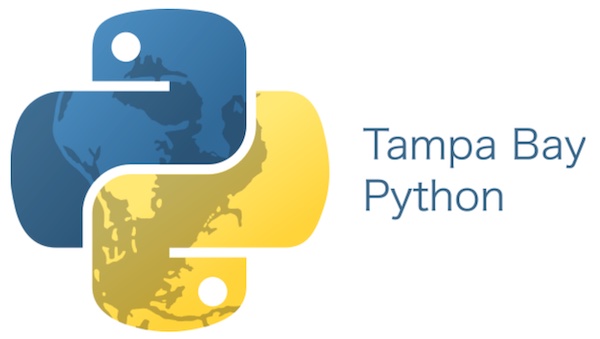
Also on Thursday: Tampa Bay Python returns with a hands-on workshop on building web applications with Django! You’ll focus on fixing bugs in an existing code repository for a voting web application, accompanied by hints and tips to help you resolve the issues. No prior knowledge of Django is required; you just need some familiarity with web development and programming concepts. Find out more and register here.
Also returning on Thursday: in-person Tampa Bay Lean Beer! Register and find out more here.
| Group | Event Name | Time |
|---|---|---|
| Wesley Chapel, Trinity, New Tampa, Business Professionals • Wesley Chapel, FL | Business Over Breakfast ~ Happy Hangar IN PERSON JOIN US! | Thu, Mar 16 · 7:30 AM EDT |
| Pasco County Young Entrepreneurs/Business Owners All Welcome • Wesley Chapel, FL | Happy Hangar Early Bird Professionals Networking | Thu, Mar 16 · 7:30 AM EDT |
| Professional Business Networking with RGAnetwork.net • Tampa, FL | Wesley Chapel/Lutz networking breakfast | Thu, Mar 16 · 7:30 AM EDT |
| Tampa Bay Network and Social Events • Largo, FL | LUTZ, FL – HAPPY HANGER CAFE THURSDAY NETWORKING | Thu, Mar 16 · 8:00 AM EDT |
| Agile Mindset Book Club (Tampa, FL) • Tampa, FL | 8 Week series 7 Habits of Highly Effective People | Thu, Mar 16 · 8:00 AM EDT |
| Orlando IT Community • Orlando, FL | Accelerate IT | Thu, Mar 16 · 8:00 AM EDT |
| Clearwater Entrepreneurs’ Round Table • Dunedin, FL | 2023 SPARK Your Small Business! | Thu, Mar 16 · 8:30 AM EDT |
| The Florida Business Incubator, Inc. • Dunedin, FL | 2023 Reset – Small Business SPARK! | Thu, Mar 16 · 8:30 AM EDT |
| TampaBayNetworkers • Pinellas Park, FL | Suncoast Networkers | Thu, Mar 16 · 8:30 AM EDT |
| Orlando Cybersecurity Meetup • Orlando, FL | Accelerate IT | Thu, Mar 16 · 8:30 AM EDT |
| Bootstrappers Breakfast® – Tampa Bay Area • Tampa, FL | East Coast Bootstrappers Breakfast® | Thu, Mar 16 · 9:30 AM EDT |
| BCI Integrated Solutions • Tampa, FL | BCI – Building Technology Symposium presented by Honeywell | Thu, Mar 16, 10:00 AM |
| Orlando Melrose Makers • Orlando, FL | In-Person: Makerspace Open Lab | Thu, Mar 16 · 10:30 AM EDT |
| Florida Startup: Idea to IPO • Tampa, FL | How to Cut Product Development Costs by up to 50%! | Thu, Mar 16 · 11:00 AM EDT |
| Free Tampa Women Business Owners & Entrepreneurs Networking • Tampa, FL | Free Networking Event at Raining Berries Lutz | Thu, Mar 16 · 11:00 AM EDT |
| Business Professionals of Pinellas, Pasco & Hillsborough • Largo, FL | Clearwater Professional Networking Lunch | Thu, Mar 16 · 11:00 AM EDT |
| Tampa Bay Network and Social Events • Largo, FL | Pinellas County’s Largest Networking Lunch and your invited! | Thu, Mar 16 · 11:00 AM EDT |
| Young Professionals Networking JOIN in and Connect! • Saint Petersburg, FL | The Founders Meeting where it all Began! JOIN us! Bring a guest and get a gift | Thu, Mar 16 · 11:00 AM EDT |
| Tampa / St Pete Business Connections • Tampa, FL | Clearwater/Central Pinellas Networking Lunch JOIN us and connect your business | Thu, Mar 16 · 11:00 AM EDT |
| Tampa Bay Business Networking Happy Hour/Meetings/Meet Up • Clearwater, FL | Pinellas County’s Largest Networking Lunch and your invited! | Thu, Mar 16 · 11:00 AM EDT |
| Wesley Chapel, Trinity, New Tampa, Business Professionals • Wesley Chapel, FL | Wesley Chapel Professional Networking Lunch | Thu, Mar 16 · 11:30 AM EDT |
| Pasco County Young Entrepreneurs/Business Owners All Welcome • Wesley Chapel, FL | Wesley Chapel Professional Networking Lunch at Chuck Lager America’s Tavern | Thu, Mar 16 · 11:30 AM EDT |
| Professional Business Networking with RGAnetwork.net • Tampa, FL | Breakroom Bar & Grill 11:28 Doors open at 11:00am IN Person | Thu, Mar 16 · 11:30 AM EDT |
| Simply Referrals Tampa Business Networking • Tampa, FL | The Business Networking Midday Power Hour by Simply Referrals on Zoom! | Thu, Mar 16 · 12:00 PM EDT |
| Clearwater Business Networking • Clearwater, FL | The Business Networking Midday Power Hour by Simply Referrals on Zoom! | Thu, Mar 16 · 12:00 PM EDT |
| Tampa Bay Gaming: RPG’s, Board Games & more! • Tampa, FL | Commander Open Play Night at Armada Games | Thu, Mar 16 · 1:00 PM EDT |
| Freelancers Work Remote Meetup Group • Saint Petersburg, FL | Raining Berries Coworking Meetup | Thu, Mar 16 · 1:00 PM EDT |
| ManageEngine’s Cybersecurity Meetups • Orlando, FL | Your AD also needs Zero Trust | Thu, Mar 16 · 2:00 PM EDT |
| Network After Work Tampa – Networking Events • Tampa, FL | Social Media Automation Workshop | Thu, Mar 16 · 3:00 PM EDT |
| Tampa – Sarasota – Venice Trivia & Quiz Meetup • Bradenton, FL | Trivia Night – Bunkers Bar of Sun City Center Smartphone Trivia Game Show | Thu, Mar 16 · 4:00 PM EDT |
| Tampa Professional Networking Meetup • Tampa, FL | Happy Hour Networking – Cigars, Fine Wines and Brews | Thu, Mar 16 · 5:00 PM EDT |
| Ironhack Tampa – Tech Careers, Learning and Networking • Tampa, FL | The Basics of Web Development | Thu, Mar 16 · 6:00 PM EDT |
| Tampa SEO & Internet Marketing Meetup with Steve Scott • Tampa, FL | Don’t Wait! Get Google Analytics (GA4) Setup on Your Website Now. | Thu, Mar 16 · 6:00 PM EDT |
| West Orlando WordPress Meetup • Winter Garden, FL | Aseem Bhardwaj – Lead and Innovate With a Winning Content Strategy | Thu, Mar 16 · 6:00 PM EDT |
| Network After Work Tampa – Networking Events • Tampa, FL | Virtual Cocktails and Connections | Thu, Mar 16 · 6:00 PM EDT |
| Bitcoin Key Club • Sarasota, FL | Monthly Meetup | Thu, Mar 16 · 6:00 PM EDT |
| Indian Rocks Beach D&D 5e Meetup Group • Indian Rocks Beach, FL | Curse of Strahd Session 4 | Thu, Mar 16 · 6:00 PM EDT |
| Brandon and Seffner area AD&D and Rifts (Palladium) Group • Seffner, FL | 2nd ed. AD&D Campaign. | Thu, Mar 16 · 6:00 PM EDT |
| Critical Hit Games • Saint Petersburg, FL | Warhammer Night | Thu, Mar 16 · 6:00 PM EDT |
| Orlando Board Gaming Weekly Meetup • Orlando, FL | Central Florida Board Gaming at The Collective | Thu, Mar 16 · 6:00 PM EDT |
| Clearwater Boardgame Night • Saint Petersburg, FL | Clearwater Board Game Night | Thu, Mar 16 · 6:00 PM EDT |
| Tampa Bay Python • Tampa, FL | Bugs, Fixes, and High Fives: A Django Debugging Workshop! | Thu, Mar 16 · 6:30 PM EDT |
| Tampa Bay Agile • Tampa, FL | Lean Beer for All Things Agile (Tampa) | Thu, Mar 16 · 6:30 PM EDT |
| Tampa Bay Data Science Group • Tampa, FL | TBDSG: Your Presentation Title HERE! | Thu, Mar 16 · 6:30 PM EDT |
| Makerspaces Pinellas Meetup Group • Largo, FL | Laser cutting and engraving | Thu, Mar 16 · 6:30 PM EDT |
| Orlando Data Professionals Meetup Group • Orlando, FL | The past, present and future of data workflow management (Virtual) | Thu, Mar 16 · 6:30 PM EDT |
| The Pinellas County Young “Professionals” • Saint Petersburg, FL | Happy Hour: Rooftop Series – Pier Teaki | Thu, Mar 16 · 6:30 PM EDT |
| Tampa Free Writing Group • Tampa, FL | Writing Meetup | Thu, Mar 16 · 6:30 PM EDT |
| Tampa Hackerspace • Tampa, FL | 3D Printer Orientation: Printing at Tampa Hackerspace (THS Members only) | Thu, Mar 16 · 7:00 PM EDT |
| Tampa Bay Coalition of Reason • Tampa, FL | Skept. Inquirer Presents The Birth of the Science Communicator with Dave Farina | Thu, Mar 16 · 7:00 PM EDT |
| IIBA Tampa Bay • Tampa, FL | BABOK IIBA Tampa Bay Study Group | Thu, Mar 16 · 7:00 PM EDT |
| Tampa Bay Bitcoin • Tampa, FL | Bitcoin Workshop | Thu, Mar 16 · 7:00 PM EDT |
| WEB3CFL -Art -Music -Gaming -ai -Bitcoin -Crypto -Blockchain • Orlando, FL | Web3 Talk March 2023 | Thu, Mar 16 · 7:00 PM EDT |
| Sunshine Games • Tampa, FL | FABulous Thursdays | Thu, Mar 16 · 7:00 PM EDT |
| TB Chess – Tampa Bay – St. Petersburg Chess Meetup Group • Saint Petersburg, FL | Thursday chess at 54th Ave Kava House! | Thu, Mar 16 · 7:00 PM EDT |
| Cocktails and Convo: Book club for RomCom Lovers • Pinellas Park, FL | Cocktails and Convos social hour | Thu, Mar 16 · 7:00 PM EDT |
| Live streaming production and talent • Tarpon Springs, FL | Live streaming production and talent | Thu, Mar 16 · 7:00 PM EDT |
| Indica Cafe Events • Tampa, FL | Dungeons and Dragons Thursday Nights at 7 | Thu, Mar 16 · 7:00 PM EDT |
| St. Pete Booze and Book Club • Saint Petersburg, FL | Eyes of the Dragon – Stephen King | Thu, Mar 16 · 7:30 PM EDT |
Friday, March 17
On Friday — which is also St. Patrick’s Day, Women in Tech and Entrepreneurship, a casual gathering of high-performing, non-conforming women, are meeting at Four Green Fields’ Channelside branch. Find out more and register here.
| Group | Event Name | Time |
|---|---|---|
| Winter Park Toastmasters – Learn while having FUN! • Winter Park, FL | Improve your communication, listening, and leadership skills | Fri, Mar 17 · 7:15 AM EDT |
| Entrepreneurs & Business Owners of Sarasota & Bradenton • Sarasota, FL | A.C.T. Acquire Connections Today Morning Business Networking All Welcome! | Fri, Mar 17 · 7:45 AM EDT |
| Brandon Biz Pros • Brandon, FL | Build your Business with Brandon Biz Pros | Fri, Mar 17 · 8:30 AM EDT |
| Young Professionals Networking JOIN in and Connect! • Saint Petersburg, FL | Tampa Young Professionals Virtual Networking Friday Morning All WElCOME | Fri, Mar 17 · 8:45 AM EDT |
| Professional Business Networking with RGAnetwork.net • Tampa, FL | A.C.T. Acquire Connections Today Morning Business Networking All Welcome! | Fri, Mar 17 · 8:45 AM EDT |
| Tampa Bay Networking Meetings and Mixers • Tampa, FL | Business over Breakfast Clearwater | Fri, Mar 17 · 9:00 AM EDT |
| Tampa Bay Network and Social Events • Largo, FL | Networking over breakfast | Fri, Mar 17 · 9:00 AM EDT |
| Project Codex • Orlando, FL | Virtual Coffee | Fri, Mar 17 · 9:00 AM EDT |
| Primerica Office Building • Tampa, FL | Small Business Seminar | Fri, Mar 17, 9:00 AM |
| PupilCert • Tampa, FL | Public Speaking1 Day Training in Tampa, FL | Fri, Mar 17, 9:00 AM |
| Christian Professionals Network Tampa Bay • Largo, FL | Improve Speaking Skills & Build Confidence | Fri, Mar 17 · 9:25 AM EDT |
| Business Professionals of Pinellas, Pasco & Hillsborough • Largo, FL | International Networking at McAlisters Deli every Friday | Fri, Mar 17 · 11:30 AM EDT |
| Tampa Bay Networking Meetings and Mixers • Tampa, FL | Friday Business Introductions Tampa | Fri, Mar 17 · 11:30 AM EDT |
| Tampa Bay Network and Social Events • Largo, FL | Westshore Business Networking Lunch at McAlisters Deli Every Friday All Welcome | Fri, Mar 17 · 11:30 AM EDT |
| Tampa / St Pete Business Connections • Tampa, FL | International Professionals Networking Meeting | Fri, Mar 17 · 11:30 AM EDT |
| Tampa Bay Business Networking Happy Hour/Meetings/Meet Up • Clearwater, FL | International Networking Westshore McAlisters Deli | Fri, Mar 17 · 11:30 AM EDT |
| McAlister’s Deli • Tampa, FL | 11:30 AM Friday Networking South Tampa @ McAlisters Deli International Mall | Fri, Mar 17, 11:30 AM |
| Cafe Delanie • Tampa, FL | 11:30 AM Monday Sabal Park Brandon Professional Networking at Cafe Delanie! | Fri, Mar 17, 11:30 AM |
| Business Networking for Entrepreneurs of Color • Clermont, FL | Virtual Networking Nibble – Entrepreneurs of Color | Fri, Mar 17 · 12:00 PM EDT |
| 11968 N Florida Ave • Tampa, FL | Invest like a Boss With Stefanie Peters | Fri, Mar 17, 12:00 PM |
| The Pinellas County Young “Professionals” • Saint Petersburg, FL | St. Pattys Day Primitive Camping on Shell Key | Fri, Mar 17 · 2:00 PM EDT |
| Florida Polytechnic University • Lakeland, FL | Phoenix Reignite: Students of Florida Polytechnic University | Fri, Mar 17, 2:00 PM |
| Orlando Horror Movie Fans 20s-30s • Orlando, FL | St. Patrick’s Day Crawl☘️🍺 | Fri, Mar 17 · 4:00 PM EDT |
| Clermont Nerd Games • Clermont, FL | Board Game Night! | Fri, Mar 17 · 5:00 PM EDT |
| Meeple Movers Gaming Group • Ocala, FL | Friday Night Board Games at Meeple Movers Cafe | Fri, Mar 17 · 5:00 PM EDT |
| Tampa Gaming Guild • Tampa, FL | Friday Board Game Night | Fri, Mar 17 · 5:30 PM EDT |
| Four Green Fields • Tampa, FL | Women In Tech & Entrepreneurship | Fri, Mar 17, 5:30 PM |
| Tampa Bay Gaming: RPG’s, Board Games & more! • Tampa, FL | Board Game night at The Strange Realms in Carrollwood Friday, 6 PM | Fri, Mar 17 · 6:00 PM EDT |
| Dunnellon Area Board Gamers • Dunnellon, FL | Friday Night Board Gaming | Fri, Mar 17 · 6:00 PM EDT |
| Tampa Japanese Meetup • Tampa, FL | Nihongo De Okay | Fri, Mar 17 · 6:00 PM EDT |
| Nerd Night Out • Tampa, FL | Taps & Drafts | Fri, Mar 17 · 6:00 PM EDT |
| Self-Perfected Orlando • Orlando, FL | GROWTH MINDSET | Fri, Mar 17 · 6:00 PM EDT |
| MakerFX Makerspace • Orlando, FL | MakerFX Makerspace Woodshop Guild | Fri, Mar 17 · 7:00 PM EDT |
| Nerdbrew Events • Tampa, FL | St. Pixel’s Day Party! 🌈🍀🍻 | Fri, Mar 17 · 7:00 PM EDT |
| Sunshine Games • Tampa, FL | Modern FNM | Fri, Mar 17 · 7:00 PM EDT |
| Critical Hit Games • Saint Petersburg, FL | MTG: Phyrexia All Will Be One Draft | Fri, Mar 17 · 7:00 PM EDT |
| Oviedo Middle Aged Gamers (OMAG) • Oviedo, FL | Tabletop: Friday Board Game Night | Fri, Mar 17 · 7:00 PM EDT |
| Tampa Stoics • Tampa, FL | IN-PERSON: “How to Think Like a Roman Emperor” (Chapter 7 Part II) | Fri, Mar 17 · 7:00 PM EDT |
| Dunedin Professional Meetup • Clearwater, FL | Networking Meet and Greet Happy 😊 Hour! | Fri, Mar 17 · 7:00 PM EDT |
| New Orleans | Twitter Space • Tampa, FL | What is a NFT | What is Cryptovia Biz and Night Lounge (Coming Soon) | Fri, Mar 17, 7:00 PM |
| Tampa Bay Business Networking Meetings & Mixers • Tampa, FL | International Networking at McAlisters Deli every Friday | Fri, Mar 17 · 11:30 PM EDT |
| Florida Center for Creative Photography • Saint Petersburg, FL | Monthly Cell Phone Photo Showcase | Fri, Mar 17 · 11:59 PM EDT |
Saturday, March 18
| Group | Event Name | Time |
|---|---|---|
| Central Florida Philosophy Meetup • Winter Park, FL | Wake Up and Think Clearly Saturday morning share and discuss. | Sat, Mar 18 · 7:00 AM EDT |
| Tampa Hackerspace • Tampa, FL | Volunteer Workshop: Build a TARDIS for THS! | Sat, Mar 18 · 8:00 AM EDT |
| Toastmasters Division G • Ocala, FL | Early Bird Ocala | Sat, Mar 18 · 8:00 AM EDT |
| 3701 E Fowler Ave • Tampa, FL | Entrepreneurs Speaks | Sat, Mar 18, 8:30 AM |
| Data Analytics – Tampa Bay • Tampa, FL | Data Analytics – Tampa Bay – MARCH MEETUP (Special Event) | Sat, Mar 18 · 9:00 AM EDT |
| Suncoast Drone Club • Tampa, FL | Alligator Lake Park | Sat, Mar 18 · 9:00 AM EDT |
| Toastmasters Division E • Orlando, FL | Hunters Creek Toastmasters | Sat, Mar 18 · 9:30 AM EDT |
| Chess Republic • Tampa, FL | Saturday Chess at Wholefoods in Midtown, Tampa | Sat, Mar 18 · 9:30 AM EDT |
| The Art Of Photography – Tampa/Gulf Coast Chapter • Tampa, FL | 🌐SAT 3/18 at 10 AM ONLINE PHOTOGRAPHY CRITIQUE PROGRAM | Sat, Mar 18 · 10:00 AM EDT |
| IIBA Tampa Bay • Tampa, FL | IIBA Tampa Bay day of beautification at Duran Park | Sat, Mar 18 · 10:00 AM EDT |
| Orlando Lady Developers Meetup • Orlando, FL | Code with me – learning sessions weekly on Saturdays | Sat, Mar 18 · 10:00 AM EDT |
| North Florida Stock Investing Education • Tampa, FL | South Florida Model Investment Club Meeting | Sat, Mar 18 · 10:00 AM EDT |
| Critical Hit Games • Saint Petersburg, FL | Warhammer 40K: Rogue Trader Tournament (RTT) | Sat, Mar 18 · 10:00 AM EDT |
| Orlando Melrose Makers • Orlando, FL | In-Person: Makerspace Open Lab | Sat, Mar 18 · 10:30 AM EDT |
| Tampa 30s 40s Womens Book Social Club • Tampa, FL | Book+ Social event: Big Easy Brunch! First group meeting | Sat, Mar 18 · 11:00 AM EDT |
| The Meet Suite • Brandon, FL | Lunch and Learn: How to get published this year | Sat, Mar 18, 11:00 AM |
| Women In Linux • Tampa, FL | LIVE | Tech, Stocks & Jobs | Sat, Mar 18 · 12:00 PM EDT |
| Hack The Box Meetup: Tampa, FL • Tampa, FL | SCRIPTKIDDIE & KNIFE with SLANGIN + FURIO – Hack The Box Tampa Meetup | Sat, Mar 18 · 12:00 PM EDT |
| The Pinellas County Young “Professionals” • Saint Petersburg, FL | Paddle Meetup 5 – Reggae Rise Up | Sat, Mar 18 · 12:00 PM EDT |
| Florida Center for Creative Photography • Saint Petersburg, FL | JOIN our Facebook Group, LIKE our Fan Page and Invite your Friends | Sat, Mar 18 · 12:00 PM EDT |
| Screenwriters of Tomorrow/Today, Critique Meetup • Safety Harbor, FL | Table read screenplays | Sat, Mar 18 · 12:30 PM EDT |
| Gen Geek • Saint Petersburg, FL | Imagine Dragons, Weezer, and Pitbull concert | Sat, Mar 18 · 1:00 PM EDT |
| Suncoast Makers • Sarasota, FL | FREE Fab Lab Orientation | Sat, Mar 18 · 1:00 PM EDT |
| Meeple Movers Gaming Group • Ocala, FL | D&D 101 with David! | Sat, Mar 18 · 1:00 PM EDT |
| Tampa Bay Coalition of Reason • Tampa, FL | In-person: Theater screening of “Wooden Nickels” | Sat, Mar 18 · 2:00 PM EDT |
| Casual Scrabble Play • Largo, FL | Scrabble for ALL levels! | Sat, Mar 18 · 2:00 PM EDT |
| Women In Linux • Tampa, FL | Live | How We Linux | Sat, Mar 18 · 2:30 PM EDT |
| Bradenton Photo Group • Bradenton, FL | Beyond Camera Basics | Sat, Mar 18 · 2:30 PM EDT |
| Orlando Machine Learning and Data Science • Orlando, FL | [IN-PERSON] Jupyter notebooks extensions to improve ML workflows | Sat, Mar 18 · 3:00 PM EDT |
| Tampa Book Club – Award-Winning Books • Tampa, FL | An Immense World by Ed Yong | Sat, Mar 18 · 3:00 PM EDT |
| Tampa Games Developer Guild • Tampa, FL | Game Project Therapy (Virtual) | Sat, Mar 18 · 4:00 PM EDT |
| Tampa D&D Enthusiasts • Tampa, FL | Legacy of Mana (Open 5e campaign) | Sat, Mar 18 · 4:00 PM EDT |
| 6 Figure Club Mastermind • Riverview, FL | March Monthly Meeting with Gualter Amarelo | Sat, Mar 18 · 5:00 PM EDT |
| New Port Richey Casual Games and Fun Socializing Group! • Hudson, FL | Mid March Game Night at IHOP | Sat, Mar 18 · 5:30 PM EDT |
| Indie Writers Unite • Saint Petersburg, FL | Indie Writers Unite! – Meet and Greet, 18 Mar 2023, 07:00 PM | Sat, Mar 18 · 6:00 PM EDT |
| Oviedo Middle Aged Gamers (OMAG) • Oviedo, FL | Golf Group – RPG One-Shots | Sat, Mar 18 · 6:30 PM EDT |
| Sunshine Games • Tampa, FL | Yu-Gi-Oh Evening Tournament | Sat, Mar 18 · 7:00 PM EDT |
| Nerdbrew Events • Tampa, FL | Community Hang-out Night | Sat, Mar 18 · 7:00 PM EDT |
| Central Florida AD&D (1st ed.) Grognards Guild • Winter Park, FL | THE ONE-SHOT GUILD | Sat, Mar 18 · 7:00 PM EDT |
| Gaming.net • Orlando, FL | First Outing- Arcade! | Sat, Mar 18 · 9:00 PM EDT |
| Nerd Night Out • Tampa, FL | KARAOKE NIGHT! | Sat, Mar 18 · 9:00 PM EDT |
Sunday, March 19
| Group | Event Name | Time |
|---|---|---|
| Our Photo Tribe Workshops • Tampa, FL | Better Bird photos at Fort DeSoto with OurPhotoTribe | Sun, Mar 19 · 7:15 AM EDT |
| The Art Of Photography – Tampa/Gulf Coast Chapter • Tampa, FL | 🌐SUN 3/19 at 10 AM ONLINE PHOTOGRAPHY CRITIQUE PROGRAM | Sun, Mar 19 · 10:00 AM EDT |
| Clermont Nerd Games • Clermont, FL | Warhammer 40K | Sun, Mar 19 · 11:00 AM EDT |
| Critical Hit Games • Saint Petersburg, FL | Warmachine Open Play | Sun, Mar 19 · 12:00 PM EDT |
| Makerspaces Pinellas Meetup Group • Largo, FL | Large format printing | Sun, Mar 19 · 12:00 PM EDT |
| Drunk’n Meeples West Pasco (Boardgames) • Port Richey, FL | Weekend Game Day | Sun, Mar 19 · 1:00 PM EDT |
| Tampa Gaming Guild • Tampa, FL | Sunday Gaming | Sun, Mar 19 · 1:00 PM EDT |
| Chess Republic • Tampa, FL | Sunday Chess at Grassroots Kava House in Ybor | Sun, Mar 19 · 2:00 PM EDT |
| Tampa Bay Gaming: RPG’s, Board Games & more! • Tampa, FL | D&D Adventurers League at Critical Hit Games | Sun, Mar 19 · 2:00 PM EDT |
| Toastmasters, Division D • Altamonte Springs, FL | Weekend Toastmasters | Sun, Mar 19 · 3:00 PM EDT |
| Young Women’s Book Club • Saint Petersburg, FL | Book Discussion: The Last Days of Ptolemy Grey | Sun, Mar 19 · 3:00 PM EDT |
| Sunshine Games • Tampa, FL | Sunday Pokemon League | Sun, Mar 19 · 4:00 PM EDT |
| Tampa Bay Beach and Sunset Photography and Modeling Classes • Tampa, FL | Neon nights, Shadowy Days Workshop & Group Shoot Photographer Signup Page | Sun, Mar 19 · 4:00 PM EDT |
| Brandon and Seffner area AD&D and Rifts (Palladium) Group • Seffner, FL | Rifts | Sun, Mar 19 · 5:00 PM EDT |
| Tampa Hackerspace • Tampa, FL | Sew Awesome! (Textile Arts & Crafts) | Sun, Mar 19 · 5:30 PM EDT |
| Tampa Stoics • Tampa, FL | IN-PERSON: A Walking Meditation – Causeway Trail | Sun, Mar 19 · 6:30 PM EDT |
| Monster Learn-To-Trade Forex (Online) • Winter Park, FL | 🔥LIVE Trading Evening Show on Stocks, Forex, Crypto, Etc with David Stephenson | Sun, Mar 19 · 7:00 PM EDT |
| Nerdbrew Events • Tampa, FL | Hidden Gems Night, Presented by A Duck! | Sun, Mar 19 · 7:00 PM EDT |
| Saint Petersburg Ladies book club • Saint Petersburg, FL | St. Pete Women’s Book Club | Sun, Mar 19 · 7:00 PM EDT |
| Nerd Night Out • Tampa, FL | A Duck Presents NB Movie Night | Sun, Mar 19 · 7:00 PM EDT |
| Virtual • TAMPA, FL | MINDSHOP™| AI FOR ALL | Sun, Mar 19, 7:00 PM |
Do you have any events or announcements that you’d like to see on this list?
Let me know at joey@joeydevilla.com!
Join the mailing list!
If you’d like to get this list in your email inbox every week, enter your email address below. You’ll only be emailed once a week, and the email will contain this list, plus links to any interesting news, upcoming events, and tech articles. Join the Tampa Bay Tech Events list and always be informed of what’s coming up in Tampa Bay!
